|
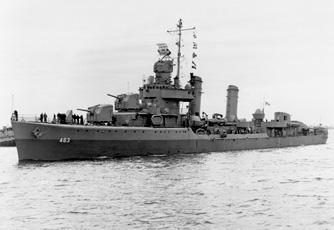
|
Robert Beeman
Officer,
USS Corry (DD-463)
(Excerpts from his 14-page D-Day account)
It has always seemed to me that
our D-Day adventure really began in mid-May of 1944, when a boat came
alongside the CORRY in Plymouth Harbor, bringing an armed officer who
carried two canvas bags that quite obviously contained books. The young man
disappeared in the direction of the captain's stateroom, and I did not see
him again. But somehow we knew that he had brought us the operation for an
invasion of Europe.
We had been hearing rumors about a second front in Europe for some time. About ten days later—it must have been June 1st—a morning came when there was a sense of electricity in the air. By midday, we realized we had not seen the captain, or the exec, or any of the department heads. While no one said so, we were sure the operation order had been opened.
That evening after dinner, Mort Rubin (our CIC Officer) and I stopped to chat with Ralph Nichols, the Assistant Communications Officer, in the cabin he shared with Art Lindh, the Communications Officer. Suddenly Lindh appeared at the door, looking pale and shaken. He looked at us and said, "If you think you're going to get scared, you'd better get off this bucket right now."
The way he said that, and the way he looked, sent chills through us. I don't think any of us had thought seriously about what a landing operation would really be like. We knew, of course, that the troops going ashore would be heading into peril, but it hadn't occurred to us that warships offshore could get into any really serious danger. From Lindh's expression, it was clear we had been very wrong. But of course he couldn't tell us what he knew.
The following morning the officers were summoned to the wardroom for a briefing, entering past armed POs at the two doors (I remember that Bill Beat was one of them).
We now learned that we would be heading for a stretch of the French coast at the western end of the Bay of the Seine, a segment of the Cotentin Peninsula that had now been code-named Utah. We would sail from Plymouth two days before D-Day, as part of unit 1B - the second part of the lead convoy in the invasion. fleet. We would steam in company with our sister destroyers FITCH and HOBSON, and we would escort four minesweepers.
[ed. note: By operation orders, the Corry sailed with convoy U-2B, which was the lead convoy]
Our mission would be to provide gunfire support to the troops after they landed. Once the first troops were ashore, we were to make radio contact with a spotter who would direct our fire. But we would reach our station an hour and a half before H-Hour. During that time, we were to fire at targets of opportunity.
And then we saw the document that must have been the real cause of Art Lindh's distress. It was a chart that showed the location of the big guns on the beach. Utah Beach was 9,000 yards long—call it five miles. Our chart showed the location of guns 75mm (3 inches) and larger, and it also showed their arcs of fire—the fan-shaped areas their shells could reach. According to this chart there were 75 of these guns. Moreover, except for a few that could only fire along the beach, virtually all of these guns covered our assigned station.
After the war was over, we learned that the estimate of 75 guns had been too low. Stephen Ambrose, in the D-Day book he published at the time of the 50th anniversary, says there were 110 guns on Utah Beach ranging from 75mm to 170mm in size. Ambrose then notes that there were another 18 guns behind the beach, including four 210mm (8.25-inch) monsters at Saint-Marcouf, a village with the same name as the off-shore islands we would pass on the way to the beach.
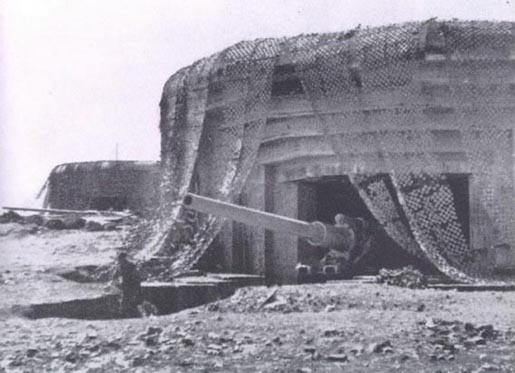
TWO OF
SAINT-MARCOUF
BATTERY'S GUN HOUSINGS
In short, we would be facing a massive array of big guns at nearly point blank range, and if we came under fire there would be no place to go. No wonder Art Lindh had looked so apprehensive.
Why would the high command send ships into a position so perilous? Stephen Ambrose reminds us that the whole point of D-Day was to put as many troops ashore as fast as possible—faster than the Germans could bring up reinforcements. To that end, the generals and admirals were prepared to sacrifice ships and planes, and just about anything else, if they had to. (Ambrose says they expected to lose at least one or two of the battleships.) While our main purpose would be to assist the troops after landing, another objective was equally clear—we were to draw enemy fire away from the landing craft by bringing it on ourselves. Plainly, we were there as targets. It could be said that our objective was to stay afloat as long as possible and do as much damage as possible while we still could. Clearly, we were expendable. I imagine that the high command was greatly relieved when D-Day came to an end and only one warship (USS CORRY) had been lost.
When the briefing conference ended on that June morning, the ship was "closed." No one was to leave or come aboard without special permission, and then only with an armed guard. Clearly the hour of departure was imminent.
(June 6, 1944) We went to General Quarters at 0400. Normally, I would have reported to the sonar station, but we could not expect submarines in the shallow waters off Utah Beach, so I had been reassigned to the wing of the bridge to assist in the navigation. We had studied the charts and identified a few landmarks that could be used as navigational aids. I was to take their compass bearings as needed.
When I reached the bridge, the St. Marcouf islands were in view off the starboard bow, several miles distant. As we approached, gunners on the islands fired what appeared to be anti-aircraft machine guns at us. We could see the tracers clearly. But we were beyond their range, and the shells fell harmlessly.
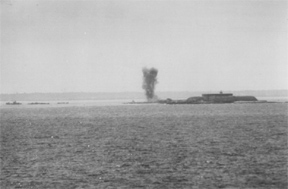
Saint-Marcouf Islands
About half an hour later, with the St. Marcouf islands astern to starboard, we reached the point where we were to turn into the channel being swept through the minefields. The minesweepers had taken a course roughly parallel to the beach, about two miles offshore. The FITCH, destined for the northernmost station, followed, then the CORRY, and finally the HOBSON. We reached our assigned station at about 0500, 3500 yards (not quite two miles) from the water's edge.
The ship slowed and soon lost headway. At that point, the captain ordered the anchor detail to drop the anchor. It was, of course, not a full anchor. That is, we didn't pay out enough chain for the anchor to hold us in position. Rather, the anchor was to serve as a marker, a reference point.
Once we anchored, I had no navigating to do, which freed me to observe what was going on. I remember looking out and thinking that everything was much calmer than I had expected. There was a steady procession of bombers over the landing area, but they were distant enough that their sound acted like a sort of acoustical sponge. It seemed to soak up all other sounds, giving the impression of an unreal quiet. I kept wondering how the morning of this portentous day could seem so peaceful. Except for the planes, little seemed out of the ordinary. The sun came up in its usual manner. The sky took on a familiar bluish haze. The sea moved in three-foot waves of a blue-gray hue I had observed many times. The coast of France looked like many another coastline. Of course, that was an illusion.
For the next hour and a half we fired occasional rounds of five-inch ammunition at the beach, but our main mission was not to begin until after H-Hour. I was occasionally asked for a bearing on some navigational aid ashore, mainly to be sure we were not dragging anchor. I remember taking a reading on the steeple at Quinéville just before H-Hour. I seem to recall that the bearing was 282. But I had little to do.
At one point, a bright orange-yellow burst appeared in the sky. I realized that one of our bombers had blown up. The plane had evidently been pulverized—I saw no debris fall out of the flames. It chilled me to realize that the victims up there had been Americans.
As H-Hour approached, a number of amphibious vessels close to the boat lanes began to throw rockets at the beach from close range. The pinkish glow of their burst was conspicuous against the background of the landing area.
Shortly before H-Hour (0630), we spotted two planes coming down from the north at a very low altitude. Friend or foe? We quickly identified them as friendly—A-20s (I think they were called Bostons). When they reached the northern edge of the fire support area, they began to lay a smoke screen. We watched them come—and saw them pass behind us, leaving us front and center against the curtain of dark smoke.
Shortly afterwards, a row of shell splashes appeared in the water to port, about 250 yards distant. I said to the talker in CIC (Combat Information Center), "They're firing at us." He asked for a repeat, but it occurred to me that since they couldn't see anything, perhaps I should not say anything further, except for "Never mind."
The captain immediately ordered the anchor up. He then turned to a young seaman and ordered him to get the bearings of the gun flashes.
In a few moments, four orange flashes appeared on the beach. I quickly saw that the seaman who had been ordered to get their bearings hadn't understood what the captain wanted, so I said to him, "Here, I'll do it," and I took over. He seemed relieved.
Meanwhile the shells were boring in on us. I have no idea how long they were in the air, but it seemed like an eternity. Finally they struck the water about 150 yards to port. They had closed in by 100 yards.
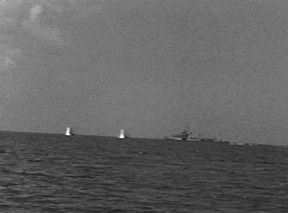
USS CORRY UNDER CLOSE FIRE
ON D-DAY
The tightness and regularity of the shell pattern indicated first class gunnery. The shells were perhaps 10 or 15 yards apart, in a neat, straight row.
The anchor was now clear of the bottom, and the captain ordered, "All engines ahead flank"—25 knots. I remember thinking, "Thank God. At least we won't be a sitting duck."
The Germans were firing very deliberately. There was a significant wait between salvoes. But now they fired another. I read the bearing and called it into the pilot house. Again we had to wait, in increasing alarm, to see where the shells would come down. The ship was now beginning to move. The captain ordered hard right rudder. A few seconds later, a new row of splashes appeared in the water just off the port bow. They were "right there"—it was like looking out of a second floor window in your house and seeing shells land in your neighbor's back yard.
The ship was now beginning to swing. Again the shore batteries fired. By this time the suspense had become excruciating. But this time I saw no shell splashes. Ensign John Pratt, on the flying bridge, later told us that the men there could see the shells in the air as they passed over and splashed to starboard.
But clearly we were on the bull's eye and our apprehension was becoming almost unbearable. And the enemy, now that he had bracketed us, proceeded relentlessly to the kill. There were four more bright flashes on the beach. I read the bearing and called it in to the pilot house. But this time there was no answer I stepped forward to the door and repeated the bearing and turned to go back to the compass repeater.
Suddenly I was in midair, flying some ten or fifteen feet down the deck. I had a brief struggle to regain my balance, at the same time trying to dodge a shower of miscellaneous debris coming down from the flying bridge.
I had several instantaneous impressions. My first was, "So that's what it's like to be hit." At the same time, I saw that my phones and helmet had been blown off my head and thrown aft. Steam was shooting up around the forward stack. Two, possibly three men, were in the water, waving to us. I realized with a chill that there was no way we could stop to help them.
I have found that in emergencies, my natural instinct is to restore order and try to keep going. I picked up the phones and helmet and put them on. But when I called CIC there was no answer.
I stepped forward to the door of the pilot house. Everywhere there was chaos and confusion. The ship's helm—a heavy metal disk two or three feet in diameter—had come out of its bearings. The helmsman had it in his hands and looked at it in perplexity, as if to say, "What am I supposed to do with this thing?" The navigator's chart desk, which had been secured to the bulkhead forward on the port side, had been torn loose and hurled across the pilot house. It now lodged, on one end, against the after bulkhead on the starboard side. Fortunately, no one's head had been in the way as it knifed through the air.
The captain ordered Van Gorp, our first class signalman, to send a blinker message to the FITCH. I followed him out to the signal searchlight, where he quickly discovered that there was no power.
The next alternative was to run up a flag signal. Van Gorp opened the General Signal Book to the appropriate page, and after a moment's discussion we agreed on EMERG TOW, which then proceeded to hoist.
I heard the captain order that our two 26-foot motor whaleboats be lowered. He wanted them to take us in tow. I heard him say, "I want to get out of here before we get hit again." I understand that the boats did get lowered, but it was too late for them to help us move out of the line of fire.
About this time, Jack Stunzi, our Gunnery Officer, having no further use of his guns, came down from the main battery director, which was located above the pilot house, and organized a small group of men to go to the after steering station to put the rudder amidships—it had been jammed hard right. I understand this detail did succeed, but by that time the CORRY was dead in the water, her forward momentum having carried her through a turn of just over 180 degrees, so that she came to a stop heading south, starboard side toward the beach.
A few moments later the captain ordered all hands to prepare to abandon ship.
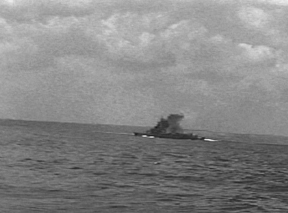
USS CORRY HIT ON D-DAY
Presently, the crew began to leave the bridge. I was in no hurry. I said to Art Lindh, our GQ officer of the deck, that since the ship was clearly out of action, perhaps the Germans wouldn't continue to fire at us. He retorted, "That's what you think." However, I felt no further explosions. In any case, with the bridge largely deserted, I decided it was time to go down to my abandon ship station.
When I reached the forecastle deck, I found several of the officers standing at the deck edge, discussing the situation. At that point, I remembered a recommendation from Jack Stunzi that if we were to get into a situation of this kind, it would be a good idea to gather up any empty five-inch powder cans, screw the caps back onto them, and toss them over the side. They might be useful as life preservers. I suggested to the others we do that and they pounced on the idea. In the next few minutes we recapped two or three dozen cans and put them over.
I still felt somewhat safer on the ship than in the water, but I knew the time was coming when I would be forced to leave her. But now, when I started toward my assigned raft, I realized that there was water over the main deck and I could not reach the raft. I would have to rely on my life jacket, which was one of those belt types inflated by squeezing together two CO2 capsules.
I decided to go over at a point on the port side near the boat davits. I saw that the end of one of our mooring lines was looped around a pair of bits.
(IN THE WATER)
I slid down the line and, once in the water, attempted to inflate my life belt. But it refused to be inflated. I could find no way to blow it up.
After a few minutes, one of the recapped powder cans came into view. I had to swim out to it.
I now began to drift away from the ship. As I came out from the protection of its lee side, I found myself in larger waves. I estimated that they averaged about three feet. In any case, they were large enough to wash periodically over my head. I found I had to be careful in timing my breathing.
I settled into a waiting pattern—continuing to fight the powder can, carefully timing my breath, and trying to figure out how I was going to get out of this situation. I was steadily getting colder—and weaker. I could feel my strength oozing out like blood from a wound. I was completely alone in the open sea, and I could see no rafts or boats or any other means of rescue. But for the moment I was busy just staying afloat.
Suddenly I felt a mild concussion, followed by a hissing sound over my head. I realized that a shell had burst in the water behind me to my right and that shrapnel had zinged over my head.
About this time I was aware that two planes were engaged in a dogfight overhead. But with my strength fast waning, I had neither the energy nor the curiosity to watch it.
I had now been alone in the water for about forty-five minutes. I had to face the fact that my energies were running out. Unless rescue came soon, I wasn't going to make it. I figured I could last another ten minutes.
Just a few minutes later, a raft came into view from behind, to my left. It was a standard 25-man raft, but there appeared to be only 8 or 9 men on it. They must have seen me, because I saw someone paddling. Then another shell landed to my right. Again I felt a concussion and heard the hissing of shrapnel over my head.
But this hit had fatal consequences. A piece of shrapnel struck one of the men on the raft and took off the top of his head. I was horrified to see the water turn red around him. I watched as the men on either side of him, too shocked to show expression, took out knives, hacked like automatons at his lashings, and set him adrift. A minute later, there was no sign that this terrible thing had happened.
One of the men stretched out an oar toward me. I was barely able to get my fingertips on it, but this was enough. I was drawn in toward the raft. I hope I didn't seem unappreciative. I was too exhausted and cold to say anything, or even to show much feeling.
I knew that the approved way of using a raft like this was to lash oneself to the ring and stay in the water outside it. I looked for a way to do this, but I found nothing I could attach myself to.
I could think of no way to survive without actually getting into the raft, and I managed to do that, though with considerable effort. I hoped no one would mind.
But this was hardly a happy solution. Once my upper body was clear of the water, I was exposed to the wind, and as the wind blew through my soaked uniform I was colder than ever. I began to wonder if I would die of exposure. But there was no way I could get back in the water and hang on.
I did have enough energy, once I had reached a stable position, to look around. I spotted the CORRY, perhaps half a mile away (though it may not have been that far), bent up into a shallow V. It was a pitiful sight.
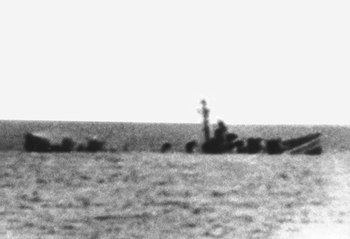
USS CORRY
SINKING ON D-DAY
After a while, I realized we were closer to the ship than before. I concluded later that some force—perhaps wind or tide—had been moving all of us slowly toward the beach, but that the CORRY, with her larger "sail area" (as they called it) had caught the wind and moved faster until it reached shallow water and the broken keel snagged on the bottom. Now the rest of us began to catch up with her.
Gradually we moved closer, and eventually we floated over the boat deck, looking up to the forecastle and bridge on the left, and to the fantail on the right. As we moved through the gap, we found ourselves in an oil slick, and then we began to choke on clouds of acrid smoke that shrapnel had released from the chemical smoke screen generators on the fantail. We hadn't needed these additional inconveniences, but we soon passed through into clearer water and air.
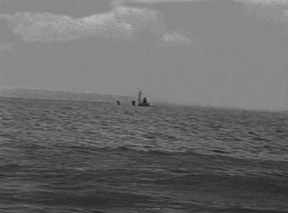
USS CORRY WRECKAGE
(RESCUE)
By that time, the FITCH had come down from the north and lowered her two boats, and the boats were busy collecting survivors. At one point, the FITCH turned away and steamed to the north—she seemed to be under fire—but she soon turned back. Eventually, one of the boats took our raft in tow and pulled us alongside the fantail, where a cargo net had been rigged.
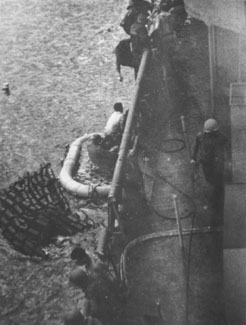
Corry survivors climbing
aboard
destroyer
USS Fitch (DD-462)
June 6, 1944
I was helped aboard and assisted in walking down the deck by two men, one on either side. I must have seemed like a zombie—I was too far gone to speak or show expressing. I was led to one of the crew compartments below the wardroom. My clothes were removed, and I was placed in a bunk and given hot coffee. (I do not normally take coffee black, and for many years, if I was served black coffee, it brought back vivid memories of this part of the D-Day experience.)
Lying in that bunk, I could hear the FITCH's guns firing, and I suffered the unpleasant thought that if the FITCH herself were to be sunk, there was no way I could go through this same experience on the same morning.
After a time, I felt able to get up. The FITCHmen were kind enough to bring clothing. As I walked around the deck, I began to meet fellow survivors. We spoke the standard greeting, "Good to see you" but now the old cliché had a deeper meaning it had never had before.
Late in the morning, I could tell from the sound of waves against the hull that the FITCH was moving more rapidly. As it turned out, she was on her way to a staging area several miles farther out from shore. Eventually, she came alongside the BARNETT, one of the troop transports, which had previously sent a number of boatloads of troops to the beach. We were transferred to her. It was nearly lunchtime, and I found my way to the wardroom. A radio was broadcasting news of the invasion. It told us the assault was failing, that the troops were being thrown back into the sea. This was sickening. I thought, "This means we'll have to do this all over again." But as it turned out, the broadcast was coming from the Germans. It was propaganda. Once we realized that, our apprehension subsided. In truth, though, no one really knew then whether the invasion would succeed.
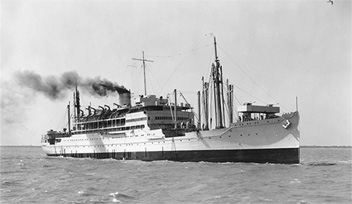
USS Barnett (APA-5) troop
ship that brought
Corry survivors
and KIA back to England
During the afternoon, we got underway for Falmouth, England.
We reached Falmouth in the midafternoon and were transferred ashore and lodged in local hostelries. Someone thought we would be entertained by seeing a movie. But it was a war movie, with lots of guns and shooting. I hardly needed this, but I felt I must force myself to endure it. I needed to know I could still manage my nerves in future times of danger.
The following morning, we were taken by train to Plymouth. The English countryside was in full bloom. I thought it one of the loveliest landscapes I had ever seen. After the ordeal of D-Day, there was something wonderfully comforting in the beauty of the fresh greens and the bursting flowers.
~
A day or so after we reached Plymouth, the captain called the officers to a conference to write the action report. We understood that he had sent a dispatch to Washington from the BARNETT that reported the loss of the CORRY and attributed it to hostile gunfire. Now he needed the support of a written document.
In the preliminary discussion, the engineering officers reported that we had been damaged in three separate locations. We agreed that we must have been hit by three of the four shells in the final salvo.
~
[An engineering officer] noted that one had pierced the de-aerating tank. "Where was that located?" the captain asked.
"Well, it was on the port side, and I think it was at about frame 84." So the captain wrote down that a shell had pierced the hull at frame 84 and ruptured the de-aerating tank.
Each of the shell hits was analyzed and reported in the same way. We concluded that the gunners had been using armor piercing shells (probably because they had been firing at the battleships until the smoke screen blocked their view) and had not changed their ammunition. (This was consistent with my impression that the first shells had not exploded when they hit the water.) We were sure that the first and third shells had not exploded, though they had caused damage. But we were certain that the second shell had struck the keel and detonated, and that it was that explosion that destroyed the ship.
When he got through, the captain had a very detailed action report that accounted for each shell and the damage it had caused. I was not convinced we could know the details that precisely, but we all agreed with the substance of the report—that we had been sunk by three of the four shells in the final salvo from the beach.
~
A few days later we heard that this action report was scrapped and replaced by another that reported that the CORRY had hit a mine. The officers were not consulted, nor were we told this new report had been written. We learned about it via the grapevine, and we were not happy about it. We considered that the evidence of gunfire was overwhelming, and none of us had experienced anything that could be taken for the blast of a mine. But obviously, we didn't have the final say.
I think it worth noting that all the damage I observed after that first hit suggested an explosion above the keel. If you visualize one of those inflatable rafts that kids play with in pools, the argument will be clear. If you place your hand under an empty raft and lift it, the two ends of the raft will dip into the water as the center is lifted. On the other hand, if a child jumps into the center of the raft, the center submerges and the two ends lift up.
All the damage I saw indicated that the CORRY's bow had been flipped upwards. I myself was thrown aft, and my helmet and phones continued in the same direction. The helm had been tossed into the hands of the helmsman standing behind it. The chart desk had been thrown from its position on the port side forward to the after bulkhead on the starboard side. If the explosion had occurred below the keel, all of these movements should have been in the opposite direction.
I have no idea why the official records state that we hit a mine. I personally do not believe we did, and neither did any of the other officers. But I have no wish to get into a crusade to "set the record straight." At this late time, it probably doesn't matter.
I wrote an account of the adventure almost immediately after I got home (1944), so that I would not lose the details or the perspective. I have been very careful not to change the story as the years went on, knowing that memory can exaggerate. The story I have told here is the same story I told my family and friends in 1944.
There is far more that could be said, of course, but there probably is no need to add to what I have already written. So I will let the story rest at this point.
Robert Beeman
Officer,
USS Corry (DD-463)
March 9, 2001